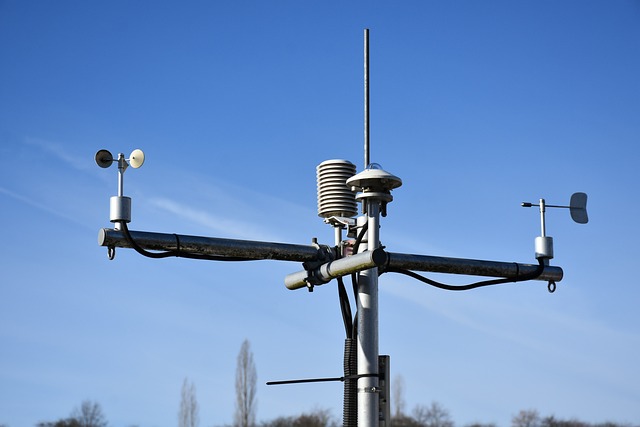Karachi, Pakistan's vibrant but vulnerable metropolis, faces escalating climate challenges marked by extreme heatwaves, intense rainfall events, and subsequent floods. Primary factors include climate change and local meteorological shifts. Authorities are responding with awareness campaigns and protective strategies for vulnerable communities, aiming to prepare the city for more frequent severe weather events. Urban planning focused on green spaces, sustainable drainage, renewable energy, and efficient buildings is crucial to enhance Karachi's resilience against these unpredictable climate impacts.
In 2023, Karachi experienced a series of unusual weather outliers, from unprecedented heat waves to severe droughts and floods. This analysis delves into these events, examining their historical context, intensity, and frequency. We explore the role of climate change in altering seasonal patterns and present a case study focusing on Karachi’s dramatic shifts. Additionally, future projections are discussed to better prepare urban areas for extreme weather events. Key insights shed light on the need for adaptation strategies tailored to this unique metropolis.
- Unprecedented Heat Waves in Karachi: A Historical Perspective
- Extreme Rainfall Events: Analysis of Intensity and Frequency
- The Impact of Climate Change on Seasonal Weather Patterns
- Unusual Weather Events: A Case Study of Karachi's Drought and Floods
- Future Projections: Preparing for Extremes in Urban Areas
Unprecedented Heat Waves in Karachi: A Historical Perspective

Karachi, Pakistan’s vibrant metropolis, has been grappling with unprecedented heat waves this year, setting new records and causing widespread concern. The city, known for its bustling streets and vibrant culture, is no stranger to hot summers, but the intensity and frequency of these heatwaves are alarming. Historical data reveals that Karachi has experienced scorching temperatures before, but the recent trend suggests a concerning upward spiral.
The extreme heat has been attributed to various factors, including climate change and local meteorological conditions. Scientists warn that such events are likely to become more frequent and severe in the coming years, posing significant challenges to the city’s infrastructure and its residents’ well-being. The unusual weather patterns have prompted authorities to take measures, focusing on public awareness campaigns and implementing strategies to combat the impact of heat on vulnerable communities.
Extreme Rainfall Events: Analysis of Intensity and Frequency

Karachi, Pakistan’s bustling metropolis, has experienced a surge in extreme rainfall events this year, causing widespread disruptions and highlighting the need for comprehensive analysis. These intense downpours, characterized by unprecedented intensity and frequent occurrence, have left an indelible mark on the city’s landscape, testing the resilience of its infrastructure and communities.
The analysis reveals that the frequency of heavy rainfall has significantly increased compared to previous years, leading to severe flooding in various parts of Karachi. The intensity of these events is evident in the intense deluges that overwhelm drainage systems, turning mundane streets into raging rivers within minutes. This phenomenon demands a closer look at urban planning, emergency response strategies, and long-term sustainable solutions to mitigate the impact of such weather outliers, especially in heavily populated areas like Karachi.
The Impact of Climate Change on Seasonal Weather Patterns

The changing climate has brought about significant shifts in global weather patterns, and Karachi, like many other cities, is experiencing the profound effects. As temperatures rise, traditional seasonal markers are becoming increasingly erratic, leading to more frequent and severe weather outliers. This year, Karachi has witnessed unprecedented heatwaves, heavy rainfall, and intense storms, all of which can be attributed to climate change. The warming planet causes changes in atmospheric circulation, altering precipitation patterns and intensifying extreme weather events.
In recent years, the city has faced challenges due to these unpredictable shifts. For instance, severe flooding in Karachi was exacerbated by rapid urbanization and changing rainfall dynamics. Climate scientists predict that without significant emissions reductions, such events will become more frequent, impacting not only Karachi’s infrastructure but also its residents’ livelihoods and overall urban resilience.
Unusual Weather Events: A Case Study of Karachi's Drought and Floods

Karachi, Pakistan’s vibrant metropolis, has recently experienced a stark contrast in weather patterns, highlighting the unusual and extreme nature of global climate shifts. This case study delves into the dramatic drought and subsequent floods that ravaged the city this year, serving as a stark reminder of the unpredictable and often severe consequences of changing weather outliers.
The absence of rainfall, an outlier in itself, led to an extended period of drought, causing water shortages and agricultural crises. This was followed by intense monsoon rains, another unusual event, resulting in devastating floods that inundated large parts of Karachi. These consecutive weather extremes have left a lasting impact, necessitating a closer examination of climate change adaptations for the region.
Future Projections: Preparing for Extremes in Urban Areas

As we look ahead, preparing for future weather extremes is paramount, especially in urban areas like Karachi, which are highly vulnerable to the impacts of climate change. Recent anomalies have underscored the need for robust adaptation strategies and resilient infrastructure to mitigate the effects of intensifying heatwaves, heavy rainfall, and extreme weather events. By leveraging advanced meteorological models and data analytics, urban planners can anticipate these challenges and design smart cities that are better equipped to handle such extremes.
In Karachi, for instance, implementing green spaces and sustainable urban drainage systems could help manage intense rainfall and mitigate flooding. Additionally, promoting renewable energy sources and enhancing energy efficiency in buildings can reduce the carbon footprint and make the city more resilient to rising temperatures. These proactive measures not only ensure the well-being of residents but also foster a more sustainable and adaptable urban environment for years to come.
In light of these remarkable weather outliers, particularly in Karachi, it’s clear that understanding and adapting to climate change is crucial. The city’s experience with extreme heat, rainfall events, and the recent drought and floods highlights the need for comprehensive urban planning and resilience strategies. By analyzing historical data and leveraging scientific insights, we can better prepare for future weather extremes, ensuring the safety and well-being of Karachi’s residents and fostering a more sustainable urban environment.
